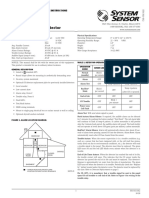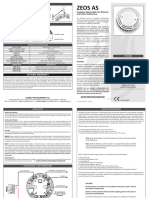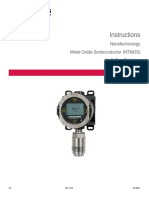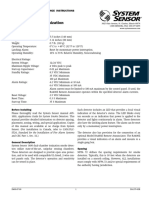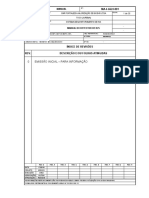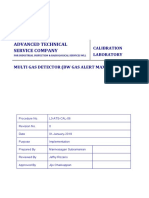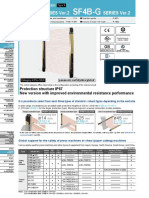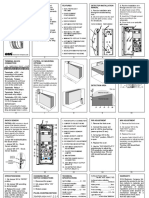400 non-addressable CO gas alarm
Installation Instructions
Optional
Cautions Remote Indicator
ELECTRICAL HAZARD: Disconnect power from equipment prior to +
making any internal adjustments. Service should only be performed by
2 3 2 3
qualified personnel.
End-of-line
FRAGILE: Inspect the equipment prior to installation. Do not install the Alarm Zone device
equipment if damage is apparent. Do not attempt to disassemble this Circuit
equipment. If damaged, return to the supplier.
ELECTROSTATIC HAZARD: This is sensitive electronic equipment. Apply 6 5 6 5
safe ant-static practices when handling this equipment. _
CIRCUIT LIMITATIONS: The maximum number of detectors connected to
a single detection zone is limited by the control and indicating equipment,
and may be limited by local regulations.
Fig. 1: 2-wire base wiring connections
Introduction
Note 1: 5-terminal base required if a remote indicator is installed.
400-series non-addressable carbon monoxide (CO) gas alarms Note 2: If a remote indicator is not installed, the polarity of the zone circuit
are suitable for connection to 2-wire and 4-wire non-addressable wiring may be reversed.
fire detection control and indicating equipment. 400 detectors can WARNING: Do not short-circuit terminals 2 and 5.
also connect to 2-wire and 4-wire addressable fire detection +
control and indicating equipment that can accept non- Power
addressable detectors1. _
Optional
Power
These instructions provide trained installation personnel with 5 6 5 6 Supervision
Relay
details to install and commission 400 CO gas alarms for optimum
performance.
Preparation Alarm Zone
3 2 3 2
Circuit
Before commencing installation, ensure all equipment (base and
detector) and tools to mount and connect the equipment are
available, such as drills, mounting screws, cables and ladders.
Fig. 2: 4-wire base wiring connections
400 CO gas alarms can be installed with the following bases and
accessories.
WARNING: Do not short-circuit terminals 2 and 5.
Description Part number Datasheet
3. Check the wiring for continuity, short circuits and earth
3-terminal 99 mm low profile faults.
487-003 31-0117
continuity base a
Output Relay (where fitted)
5-terminal 99 mm low profile
487-007 31-0117 The output relay is factory-adjusted with normally-open contacts
continuity base
b that close on alarm. The relay can be configured for normally-
Remote indicator 681-001 31-0034
closed operation as follows.
Detector monitor module 620-001 31-0027
1. Unscrew the two screws on the underside of the body of
a Onlycompatible with 400-001 only. the detector and carefully lift the cover from the body.
b Requires 5-terminal base.
2. Remove the jumper header located adjacent to the relay,
and reinsert it in the N/C position (see Fig. 3).
3. Replace the front cover and screws.
Installation Relay
Base
The base can be mounted directly onto an electrical junction box
such as an octagonal (75 mm, 90 mm or 100 mm), a round
(75 mm), or a square (100 mm) box without using any type of
mechanical adapter.
1. Feed the conductors through the middle of the base for
termination to the base contacts. N/O N/C
2. Mount the base on the junction box or directly onto a flat
surface.
3. Mount the base to the surface using fixing screws that are
suitable to securely fix the base to the surface.
Wiring
Base terminals will accept (0.4 ~ 2.5) mm2 conductors.
1. Strip the conductor insulation to expose 5 mm of the
conductor.
2. Connect the conductors to the base terminals.
a. See Fig. 1 for detectors using 2-wire bases.
Reed Switch LED
b. See Fig. 2 for detectors using 4-wire bases.
WARNING: Take care to ensure the insulation does not get Fig. 3: Adjusting the output relay
clamped by the terminal contact.
1 May be used with the 620-001 detector monitor module.
www.numens.com 1 32-0005-r05_2019-12
�Detector
WARNING: Do not install the detector head until the area is
thoroughly cleaned of construction debris, dust, etc.
1. Align the detector alignment mark with the short alignment
mark in the base, as shown in Fig. 4.
2. Mate the detector head onto the base and rotate it clockwise
to secure it. The long alignment marks should be aligned.
Fig. 4: Fitting the detector to the base
Commissioning
Gas Detector
1. Ensure all the alarm signal services, releasing devices and
extinguisher systems are disabled during the commissioning
period.
2. Connect power to the detector for approximately 10 min.
3. At the end of the start-up time, check that the red LED
flashes every 5 s. If the LED fails to flash, it indicates the
detector is not operating. Check the wiring for the correct
voltage and earth leakage. Replace the detector if
necessary.
4. Initiate a simulated alarm condition by placing a magnet on
the cover of the detector, between the LED and the sounder
grill.
5. Remove the magnet when the alarm condition is released.
6. Observe that the LED is on steady and the sounder is
operating.
7. Reset the alarm at the control and indicating equipment.
8. Listen for the sounder to silence and the LED returns to
flashing.
Output Relay (where fitted)
1. Follow Gas Detector procedure steps 4 ~ 5.
2. Monitor the output relay for activation.
3. Reset the detector at the control and indicating equipment.
4. Monitor the output relay resets to its quiescent setting.
Final Conditions
Ensure all the alarm signal services, releasing devices and
extinguisher systems disabled for the commissioning are returned
to their previous condition.
References
Document Description
31-0012 400 non-addressable CO gas alarm datasheet
View the complete range of products at
www.numens.com
2 32-0005-r05_2019-12
Numens
55 Yunhui Road, Yunlong Town, Yinzhou District, Ningbo, Zhejiang 315137 China
© 2015 ~ 2019 Ambest Electronics (Ningbo) Co Ltd. All rights reserved. All specifications and other information shown were current at the date of
publication and subject to change without notice.










